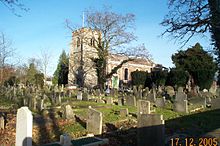
Edgware is a suburban town in northern Greater London, mostly in the London Borough of Barnet but with some parts falling in the London Borough of Harrow. Edgware is centred 9.5 miles (15.3 km) north-northwest of Charing Cross and has its own commercial centre. Edgware has a generally suburban character, typical of the rural-urban fringe. It was an ancient parish in the county of Middlesex directly east of the ancient Watling Street, and gives its name to the present day Edgware Road that runs from central London towards the town. The community benefits from some elevated woodland on a high ridge marking the Hertfordshire border of gravel and sand.

Johann Christoph Pepusch, also known as John Christopher Pepusch and Dr Pepusch, was a German-born composer who spent most of his working life in England. He was born in Berlin, son of a vicar, and was married to Margherita de l'Epine who also performed in some of his theatrical productions.

Louis Laguerre was a French decorative painter mainly working in England.

James Brydges, 1st Duke of Chandos, was an English landowner and politician who sat in the English and British House of Commons from 1698 until 1714, when he succeeded to the peerage as Baron Chandos, and vacated his seat in the House of Commons to sit in the House of Lords. He was subsequently created Earl of Carnarvon, and then Duke of Chandos in 1719.
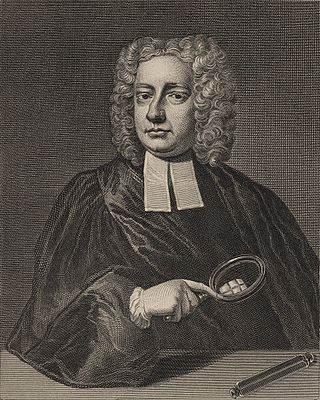
John Theophilus Desaguliers FRS was a British natural philosopher, clergyman, engineer and freemason who was elected to the Royal Society in 1714 as experimental assistant to Isaac Newton. He had studied at Oxford and later popularized Newtonian theories and their practical applications in public lectures. Desaguliers's most important patron was James Brydges, 1st Duke of Chandos. As a Freemason, Desaguliers was instrumental in the success of the first Grand Lodge in London in the early 1720s and served as its third Grand Master.
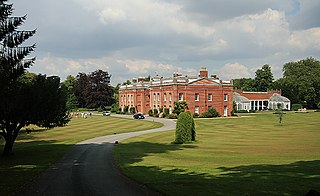
Avington is a small village and former civil parish, now in the parish of Itchen Valley, in the Winchester district, in the county of Hampshire, England. In 1931 the parish had a population of 198. On 1 April 1932 the parish was abolished to form Itchen Valley.

Cassandra Willoughby, Duchess of Chandos was an English historian, travel writer and artist. She spent more than a quarter-century overseeing the restoration of the gardens and rebuilding of the family mansion at Wollaton Hall, now in Nottingham.

Antonio Bellucci was an Italian soldier who became a painter of the Rococo period and was best known for his work in England, Germany, and Austria. He was one of the many Venetian-trained artists of his time, including Ricci, Tiepolo, Amigoni, and others, who sought commissions north of Italy, providing patrons with the then-popular Italianate grand-manner frescoes for private palaces.

Henry Wylde was an English conductor, composer, teacher and music critic.

Henry Brydges, 2nd Duke of Chandos, KB, known from 1727 to 1744 by the courtesy title Marquess of Carnarvon, was the second son of the 1st Duke of Chandos and his first wife Mary Lake. He was the Member of Parliament for Hereford from 1727 to 1734, for Steyning between 1734 and 1741, and Bishop's Castle between 1741 and 1744.

James Brydges, 3rd Duke of Chandos PC, styled Viscount Wilton from birth until 1744 and Marquess of Carnarvon from 1744 to 1771, was a British peer and politician.
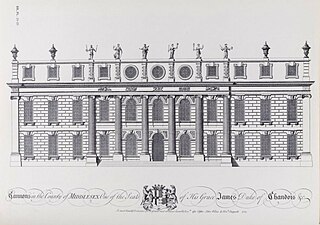
Cannons was a stately home in Little Stanmore, Middlesex, England. It was built by James Brydges, 1st Duke of Chandos, between 1713 and 1724 at a cost of £200,000, replacing an earlier house on the site. Chandos' house was razed in 1747 and its contents dispersed.
Little Stanmore was an ancient parish of Middlesex which is today the residential area of Canons Park in the London Borough of Harrow, England. The parish included the western part of the town of Edgware.
Edward Shepherd was a prominent London-based English architect and developer in the Georgian period.

George Frideric Handel was the house composer at Cannons from August 1717 until February 1719. The Chandos Anthems and other important works by Handel were conceived, written or first performed at Cannons.
Francesco Sleter was an Italian painter, active in England.
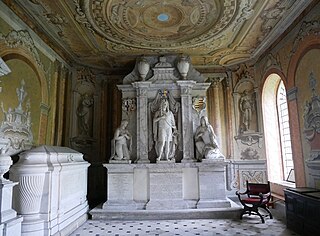
The Chandos Mausoleum is an early 18th-century English Baroque building by James Gibbs in the care of the Churches Conservation Trust. The mausoleum is attached to the north side of the church of St Lawrence Whitchurch in the London Borough of Harrow, England. The church including the mausoleum is recorded in the National Heritage List for England as a designated Grade I listed building.

Chandos Jubilate, HWV246, is a common name for a choral composition by George Frideric Handel. It was published as the first of the Chandos Anthems, and is known also as Chandos Anthem No. 1 and as Jubilate in D Major. A setting of Psalm 100, "O, be joyful in the Lord", it is the first in a series of church anthems that Handel composed between 1717 and 1718, when he was composer in residence to James Brydges, later 1st Duke of Chandos. The anthem was probably first performed at St. Lawrence's church, Whitchurch, near Brydges' country house. The work is written for a small ensemble of instrumentalists, solo singers and choir, and is approximately twenty minutes in length.

St. Lawrence, Whitchurch, is a Church of England parish church in Little Stanmore in the London Borough of Harrow, England. The building is Grade I listed. It retains a stone tower dating from ca. 1360, but the main body of the building was constructed in the 18th century in Baroque style.

Chandos Anthems, HWV 246–256, is the common name of a set of anthems written by George Frideric Handel. These sacred choral compositions number eleven; a twelfth of disputed authorship is not considered here. The texts are psalms and combined psalm verses in English. Handel wrote the anthems as composer in residence at Cannons, the court of James Brydges, who became the First Duke of Chandos in 1719. His chapel was not yet finished, and services were therefore held at St Lawrence in Whitchurch. The scoring is intimate, in keeping with the possibilities there. Some of the anthems rely on earlier works, and some were later revised for other purposes.



